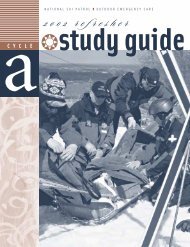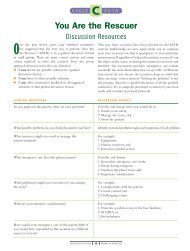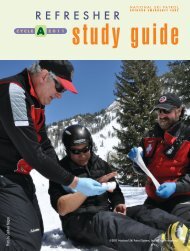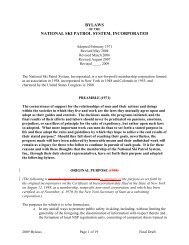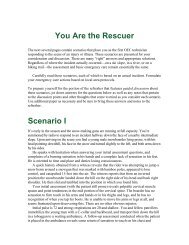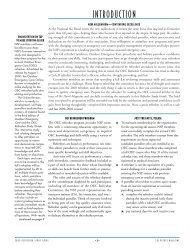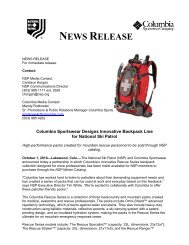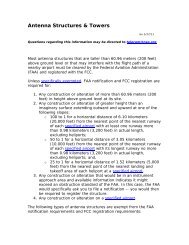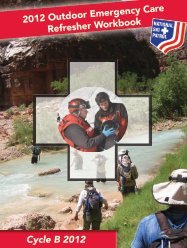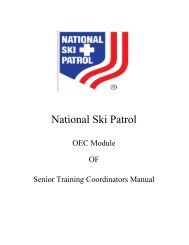Sierra Samaritans - National Ski Patrol
Sierra Samaritans - National Ski Patrol
Sierra Samaritans - National Ski Patrol
You also want an ePaper? Increase the reach of your titles
YUMPU automatically turns print PDFs into web optimized ePapers that Google loves.
outdoor emergency care<br />
❚ CONTINUED FROM PAGE 65<br />
makes a very sturdy bandage, which is an<br />
advantage if the patient has to ski out or<br />
be evacuated from the backcountry.<br />
Moreover, a cravat can be improvised<br />
from any spare piece of cloth. A simple<br />
pressure bandage for the arm, leg, forehead,<br />
or ear requires no special technique—just<br />
wrap it around a few times<br />
and tie it, maintaining the tension by<br />
passing the tails from hand to hand as you<br />
wrap. A bandage for the elbow or knee,<br />
however, needs to be anchored proximally<br />
and distally to ensure the bandage will<br />
stay on (fig. 5).<br />
❚ Apply the bandage while the arm or<br />
leg is straight so that flexing the joint<br />
will tighten (not loosen) the bandage.<br />
❚ Capture the dressing on the elbow or<br />
knee with the center of the cravat.<br />
❚ Wrap one tail proximally and the<br />
other distally to the joint so that there<br />
is a complete wrap on either side.<br />
❚ As you continue wrapping the tails<br />
around the limb, cross them to lock<br />
the bandage.<br />
❚ Tie the tails together with a square<br />
knot on the outside of the limb.<br />
figure 5<br />
figure 6<br />
Elbow Cravat Bandage<br />
Hand Cravat Bandage<br />
ILLUSTRATIONS BY EVELYN SINCLAIR<br />
You can also use a cravat to do a figureeight<br />
bandage of the hand, similar to the<br />
gauze roller bandage. Just lay the center of<br />
the cravat over the wrist, wrap both tails<br />
diagonally over the hand to secure the<br />
dressing, then bring them diagonally back<br />
to the wrist to tie them off.<br />
For severe bleeding of the palm, you<br />
can apply more pressure with a variation.<br />
Lay a dressing on the palm, then have the<br />
patient make a fist around a spare roller<br />
bandage or other padding (fig. 6).<br />
❚ With the injured hand extended<br />
palm up, lay the center of the cravat<br />
over the wrist.<br />
❚ Wrap one tail diagonally across the<br />
back of the hand, and diagonally<br />
back to the wrist.<br />
❚ Maintaining the tension, wrap the<br />
other tail diagonally across the hand<br />
and diagonally back to the wrist,<br />
making an X.<br />
❚<br />
❚<br />
Notice that each tail of the cravat is<br />
pulling two of the fingers tight into<br />
a clenched fist.<br />
Wrap the tails around the wrist and<br />
tie them off.<br />
To secure a dressing over a scalp wound,<br />
you can use a triangular bandage in a<br />
configuration that resembles a turban<br />
(fig. 7, page 68):<br />
❚ After placing a dressing on the scalp<br />
wound, lay the bandage over the<br />
head with the point hanging down<br />
the back of the neck and the straight<br />
edge around the forehead just above<br />
CONTINUED ON PAGE 68<br />
66 <strong>Ski</strong> <strong>Patrol</strong> Magazine | Winter 2005




